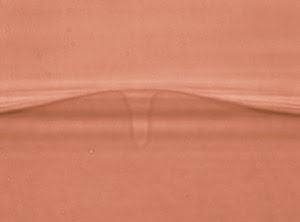Light scattering from a laser beam produces a jet stream in a water-in-oil mixture.
David L. Shenkenberg, Associate News Editor
Lasers can do many things, including pushing particles and trapping them. Theoretical physicists from the University of Chicago predicted that lasers also can influence fluid flow. Together with experimentalists from the University of Bordeaux I in Talence, France, they have shown that a laser can produce a jet stream in a liquid solution.
The investigators designed the liquid solution to separate into two layers above 35 °C, just above room temperature, so that they could easily observe laser-induced fluid flow from deformations at the interface between the layers. The liquid solution essentially consisted of micelles — a suspension of water nanodroplets coated by a shell of soap (sodium diodecyl sulfate) in oil (toluene). Above 35 °C, the mixture separates into two layers of micelle suspensions with distinct concentrations.
To induce fluid flow, the researchers needed only minimal laser power and a wavelength that would not be absorbed to prevent unwanted effects such as laser heating. They used a TEM00 CW argon-ion laser from Coherent Inc. of Santa Clara, Calif., with 2-W maximum output at 514 nm. To determine the flow rate, they measured droplets emitted at the end of the jet stream because they formed regularly with time. To record the droplets, they used a standard imaging setup that included a Hamamatsu CCD camera and a National Instruments frame grabber.

Figure 1. Researchers demonstrated that light scattering from a laser propagates fluid flow in the direction of the laser beam. Images courtesy of Alexis Casner, University of Bordeaux I, Talence, France, and reprinted with permission of Physical Review Letters.
They aimed the laser toward the soft interface separating the two micelle suspensions. Light scattering downward from the laser produced a downward fluid jet stream (Figure 1), and pointing the laser upward resulted in a large upward deformation, also caused by light scattering. In addition, the researchers observed small deformations at the interface when the laser was aimed downward and upward (Figure 2).
Jean-Pierre Delville, the senior experimental physicist with the team, said, “Laser-induced flow from light scattering always occurs in the direction of propagation. The deformation that goes downward for both upward and downward beams is not linked to light-induced flow but from radiation pressure.” The radiation pressure-driven deformation travels toward the bottom suspension because it has the lowest refractive index. He said that laser-induced fluid flow is a bulk effect that can occur only in a suspension, and radiation pressure can exist only in the presence of an interface. Laser-induced fluid flow cannot happen in pure water.

Figure 2. Radiation pressure, caused by differences in refractive indices in the fluid, produced a small deformation independent of the direction of the laser beam.
To describe laser-driven fluid flow, the theoretical physicists developed a hydrodynamic model that included optical forces. They related the vertical velocity of fluid flow to the beam size, laser power, interaction of light with refractive index fluctuations and a constant. They noted that the flow strength does not depend on the beam size. The experimental measurements agreed well with the model, as described in the March 30 issue of Physical Review Letters.
The researchers stated that a laser system may be useful for driving fluid flow through channels in microfluidic systems. It may enable more rapid changes in fluid flow than syringe pumps — the equipment currently used to drive fluid flow in microfluidic systems.